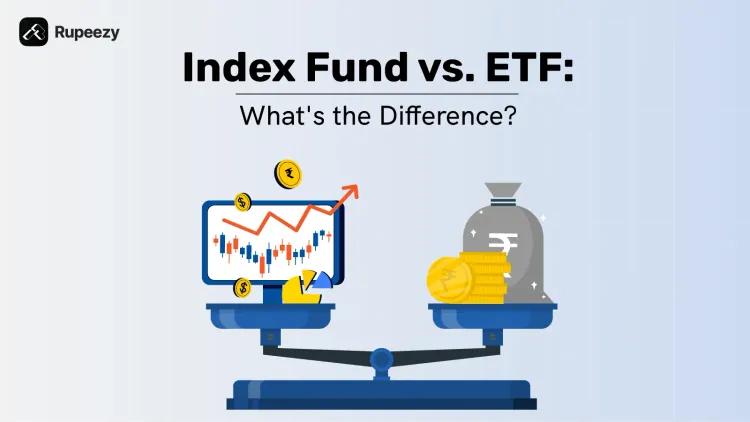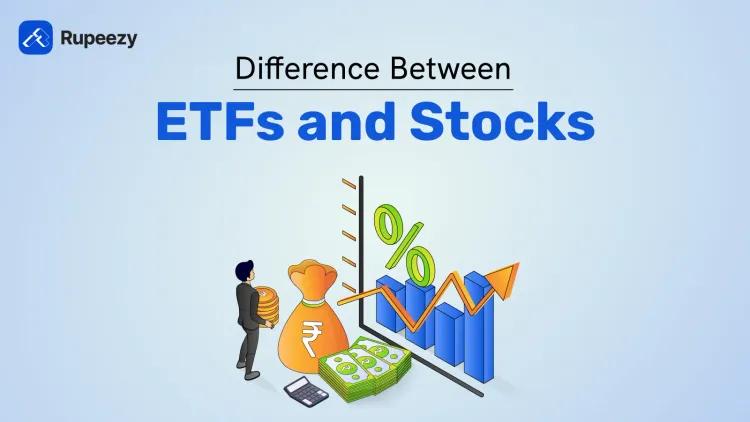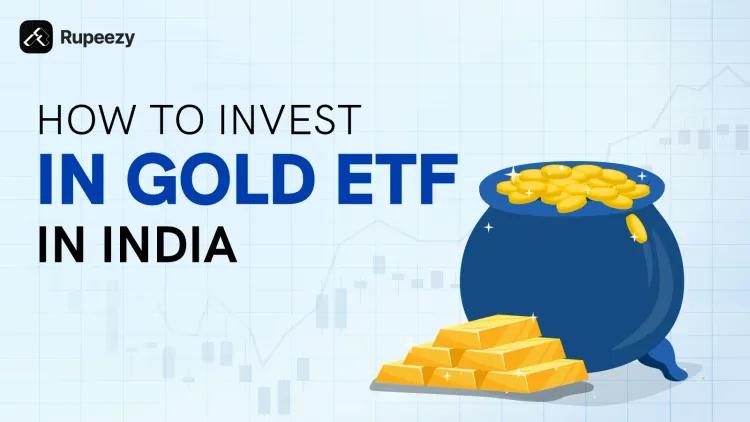6 Types of ETFs in India: Find the Best for Your Portfolio


00:00 / 00:00
The exchange-traded funds or ETFs are one category of investment funds that can be traded on stock exchanges, just like stocks. They give you the dual benefits of investing in stocks and mutual funds, offering flexibility and cost-effectiveness in diversifying your investments. Since they can spread risk across different assets and sectors, many investors are now resorting to ETFs. Read on as we look through the different types of ETF in India to help you make an informed investment choice and fit your investment with your financial goals.
What is an ETF?
An ETF is a pool of funds that you buy or sell on the stock exchanges. It is very similar to how one trades stocks and is made up of different assets like stocks, bonds, or commodities. In turn, you are able to invest in a broad range of financial instruments through a single purchase. By investing in an ETF, you are, in actuality, holding shares representing ownership in a part of the assets the fund holds. This means that you indirectly own the underlying assets and can benefit from the dividends, interest, and other profits.
How do ETFs work?
The structure is very simple: it's a fund that pools money from many investors to purchase a diversified portfolio of assets. As the day goes on, your ETF shares change in value, just like a stock so this gives you the opportunity to catch changes in price.
The biggest advantage of ETFs is diversification. Since it holds a mix of assets, the risk is spread, and the effect of the underperformance of any single investment is lessened. On the other hand, these ETFs also have high liquidity: they are easily tradable or realized into cash during market hours. Liquidity implies ease in buying or selling them, thus giving you flexibility to manage your assets. In other words, ETFs are a simple and effective way of building a diversified portfolio easily in the trading process on stock markets.
List of Different Types of ETFs in India
Equity ETFs
Bond ETFs
Commodity ETFs
Sector and Industry ETFs
International ETFs
Thematic ETFs
Overview of Types of ETF in India in 2025
Below are the different types of ETF in India:
1. Equity ETFs
Equity ETFs are the funds that primarily consist of your investment in stocks. These ETFs track equities indexes or some specific sector, giving you an all-round exposure to the stock market. In fact, an example here is the Nifty 50 ETF, where you can invest in the top 50 companies listed in the NSE like the Kotak Nifty ETF. So, it gives an easier way of capturing the overall performance of the market.
Your money in a single ETF is diversified across sectors, which dilutes the risk tied to individual stocks. This effectively means that equity ETFs are not just an investment for growth but also a good tool for the management of risks. With so many options available, you can, therefore, choose equity ETFs that meet your investment goals, be it large-cap stocks, growth stocks, or a specific market sector.
2. Bond ETFs
One of the most popular types of ETFs in India is a bond ETF. These are funds where you invest your money in bonds or fixed-income securities. When you invest in bond ETFs, you get steady streams of income with relatively lesser risk as compared to equities. These ETFs host several bonds, be it government, corporate, or municipal bonds; hence, they provide diversified exposure to the bond market.
For example, with a Nifty BHARAT Bond Index, you get exposure to bonds of AAA-rated CPSEs (Central Public Sector Enterprises), CPSUs (Central Public Sector Untertaking), CPFIs and other Government organizations. One of the key advantages of bond ETFs is lowering overall volatility in your portfolio. Since bonds generally have less risk compared with equities, adding bond ETFs to your portfolio will assist in striking a balance with the level of risk while providing regular income.
If you want a stable investment with predictable returns, bond ETFs are a great option to consider as part of your asset allocation strategy.
3. Commodity ETFs
Commodity ETFs are those you invest in physical commodities like gold, silver, oil, or some other agricultural product. These ETFs replicate the price changes of these commodities so that you can be exposed to their values without purchasing the actual physical assets. An example is a Gold ETF like the HDFC Gold ETF, which will allow an investment in gold, while another such ETF, would be a Silver ETF like the Kotak Silver ETF for exposure to silver prices.
The biggest benefit of commodity ETFs is a hedge against inflation and market volatility. These ETF types will help balance your portfolio and take down some risk, as very often, the trend in commodity prices deviates from both stocks and bonds. They may even protect your investments in times when the economy is uncertain. This makes the commodity ETF a good way to stabilize the portfolio. Commodity ETFs are a great way to safeguard your finances from market fluctuation.
4. Sector and Industry ETFs
In sector and industry ETFs, one focuses on a specific sector or industry, such as technology, FMCG (fast-moving consumer goods), or healthcare. One gets to invest through these ETFs in the targeted area of the economy, which provides him or her with exposure to those industries that have great potential to grow widely. For example, when choosing an information technology ETF, you will be investing in large technology companies, while with a healthcare ETF, you will focus on companies from the healthcare sector.
One of the main benefits of sector and industry ETFs is that they provide targeted exposure. If you feel that a particular industry is going to thrive, investing in a sector ETF will help you take advantage of that opportunity. In addition, such funds offer liquidity and provide an opportunity for an investor to buy and sell shares with ease during a particular trading day, like individual securities. This makes the sector and industry ETFs flexible to link your investments with the market trend in India.
5. International ETFs
International ETFs allow you to diversify your portfolios outside India by investing in foreign markets. These ETFs target foreign-based securities, providing the investor with exposure to global growth opportunities.
For example,the Mirae Asset S&P 500 Top 50 ETF which focuses on large-cap U.S. companies. It offers you stability and long-term growth. If the tech sector really interests you, one of the largest technology funds is the Mirae Asset NYSE FANG+ ETF. This fund invests in leading U.S. technology companies, tapping into innovation and rapid growth. There is also the Nippon India Japan Equity Fund, like the MSCI, which allows you to invest in Japanese shares.
The key advantage of international ETFs is diversification across global markets. You reduce the reliance on just the Indian economy. With such exposure being global, you will have the benefits coming from economic growth in other parts of the world, balancing risks and opportunities. However, you should be aware that relatively higher risks with regard to international ETFs are possible, especially if you concentrate on just one country.
6. Thematic ETFs
Thematic ETFs enable you to focus on very specific investment themes or trends, such as clean energy or artificial intelligence. You are able to get exposure to sectors or technologies where you expect to have extremely high growth rates. One example is the CPSE ETF, which targets firms in the Central Public Sector Enterprises.
The good thing about thematic ETFs is that you can get direct exposure to new trends and innovation-based sectors. For instance, renewable energy and technology-driven investors can take positions in such themes as pure-play investments that are shaping our future. They offer early access to high-growth sectors and also help in properly diversifying investments, focusing on niche markets. Keep in mind that these ETFs can be more volatile because they focus on specific trends.
Thematic ETFs are investments in your beliefs of what the growth areas of tomorrow will be and how to stay ahead of the trend.
Which ETF is Best for You?
Before you choose the right types of ETF in India, you have to consider several factors:
Investment goals: Decide what your financial objectives are. Is your interest in long-term growth, regular income, or diversification? For growth, you can go for equity ETFs. For income, bond ETFs might be better.
Risk tolerance: How much risk are you willing to take? If you prefer lower risk, you can go for bond or commodity ETFs. If you can handle higher risk for potentially higher returns, thematic or sector ETFs are your best fit.
Market exposure: Decide if you want local or global exposure. International ETFs give you access to the global market, while sector or thematic ETFs provide targeted exposure to specific industries or trends.
Fees and costs: Compare the expense ratios of different ETFs. Lower fees generally mean higher returns for you in the long run.
Performance history: You can't just invest, you have to look at past performance and how the ETF tracks its index. Consistent performance can mean reliability.
Tips for Evaluating ETFs
Check the ETF’s track record and performance.
Compare the ETF’s fees with similar options.
Review the ETF’s underlying assets to ensure they match the goals of your investment.
Monitor the ETF’s liquidity to ensure you can easily buy and sell.
After considering all these factors, you can then select an ETF that aligns with your investment goals and risk tolerance.
Conclusion
There are different types of ETF in India. Each of them has unique benefits. Equity ETFs provide diversification across stocks, while bond ETFs offer regular income with lower risk. Commodity ETFs let you invest in physical assets like gold, and sector ETFs focus on specific industries. International ETFs give you access to global markets, and thematic ETFs target emerging trends.
To choose the right ETF, match it with your goals, risk tolerance, and market exposure. For a free-flow trading experience and competitive rates, try Rupeezy. As India’s top discount stock broker, Rupeezy gives you easy access to diverse ETFs and excellent trading tools. Start investing smartly with Rupeezy today.
Check Out These Related Articles |
The content on this blog is for educational purposes only and should not be considered investment advice. While we strive for accuracy, some information may contain errors or delays in updates.
Mentions of stocks or investment products are solely for informational purposes and do not constitute recommendations. Investors should conduct their own research before making any decisions.
Investing in financial markets are subject to market risks, and past performance does not guarantee future results. It is advisable to consult a qualified financial professional, review official documents, and verify information independently before making investment decisions.

All Category










